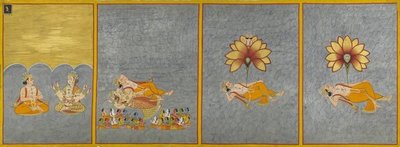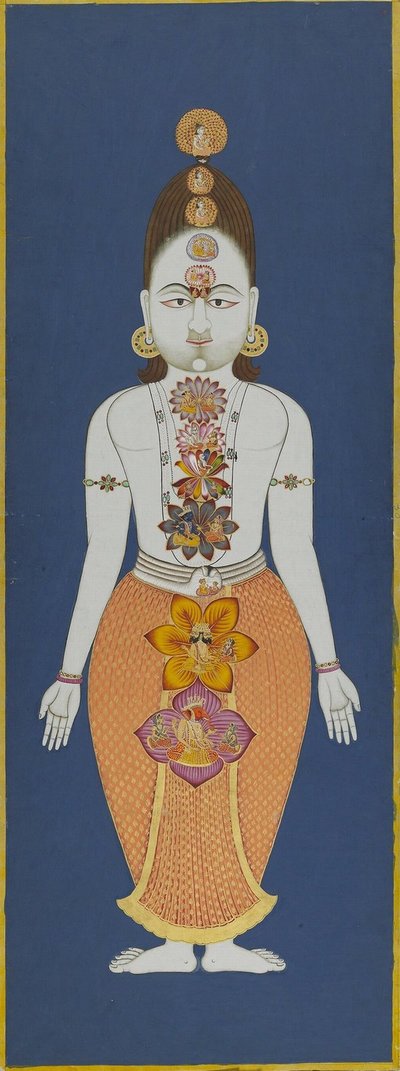February 5, 2009
UW scholars to discuss Seattle Asian Art Museum exhibit of paintings from Indian history
South Asian scholars at the University will be lending their expertise during a recently-opened exhibit at the Seattle Asian Art Museum that they have greatly anticipated. The exhibit, called Garden and Cosmos: The Royal Paintings of Jodhpur, includes 57 paintings spanning the 17th to the 19th centuries in India. But what has the scholars excited is this: Virtually none of the paintings has been published and most have been seen by only a handful of scholars since their creation.
The paintings were done at the behest of the maharajas of Marwar-Jodhpur, a kingdom in Northwest India (Jodhpur is the capital), and come from the Mehrangarh Fort Museum, thanks to the generosity of the Mehrangarh Trust, headed by the current Maharaja Gaj Singh II of Jodhpur. The Seattle Asian Art Museum is one of only two venues in the United States hosting the exhibit; it was first shown at the Arthur M. Sackler Gallery, a part of the Smithsonian Institution in Washington, D.C.
On Thursday, Feb. 19, UW scholars will participate in an interdisciplinary panel at the museum aimed at the general public. They’ll discuss the cultural, historical, literary and social context of the works featured in the exhibition. Several will also be involved in conducting tours.
The panel, which is free with museum admission, will be held at 7 p.m. in the Stimson Auditorium of the Seattle Asian Art Museum in Volunteer Park. The conference runs from 10:30 a.m. to 3 p.m. in the same location. It is $8 for adults, $6 for students and seniors and $4 for musuem members.
She’ll be discussing “Krishna and the Naths: Eroticism and Asceticism,” to explain part of the subject matter of the paintings. The garden of the exhibit title refers to the earlier paintings in the collection, which depict the Hindu god Krishna in a kind of idealized garden setting. The later paintings are much more abstract and attempt to illustrate the cosmology of a yogic sect, the Naths, who were supported by one of the maharajas.
Pauwels is interested in the paintings because, as a scholar of the Hindi language, she has studied texts that are associated with art. She told the story of how the maharaja became involved with the Naths:
“He was the rightful heir but his throne had been usurped by somebody else. He took shelter in one of the minor forts in the region, where he was besieged. He was about to surrender when one of his Nath advisers is supposed to have come to him and said, ‘If you can hold out for a few more days, then you will not only have this fort, but the whole of your kingdom will come back to you.’ So he did hold out, and lo and behold, his rival died in a few days. Of course there are rumors that his death might have been hastened by some poison, but you can imagine that when this young desperate man came to the throne, thanks to this prediction, he was very grateful to that order of monks and he started sponsoring them.”
Part of that sponsorship was to commission paintings that illustrated the Naths’ beliefs, which didn’t involve human-like gods cavorting in gardens.
Commissioning art was one of the ways the maharajas asserted power during the British colonial period, said Purnima Dhavan, assistant professor of history, who will talk about “Patronage and Power” as part of the panel.
“They found that their political and economic wings had been clipped by colonialism, but art and art patronage became a way of reasserting their identity and power locally and also creating these new networks of influence that flew under the radar of the colonial state, which dismissed it as a religious matter,” she said.
Other UW speakers on the panel are Michael Shapiro, chair of Asian languages and literature, who will talk about “Rasa Theory”; and Anand Yang, director of the Jackson School of International Studies, who will talk about “Princely and Colonial States.” All four scholars are part of the UW’s South Asia Center, which brings together faculty from various departments who are interested in South Asia. The panel will be moderated by the center’s director, Priti Ramamurthy
The exhibit was curated by Debra Diamond, the associate curator of South and Southeast Asian art at the Freer Gallery of Art and the Arthur M. Sackler Gallery at the Smithsonian Institution. She had studied the paintings as part of her dissertation. Pauwels said that because the collection was a private one owned by the maharajas, few had seen it before Diamond’s work.
“It’s amazing she got it out as an exhibit,” Pauwels said. “Usually you’re happy to have gained access yourself and maybe photograph it so you can publish it. But very little of this work had been published until now.”
Which is why the UW scholars are so excited that the exhibit is here and they’ll be able to see the works in person.
Diamond spoke at the exhibit opening last week and will return for a conference March 27-28, at which Dhavan is also speaking. The conference is open to the public, although the presentations will be of a scholarly nature. The exhibit will remain in Seattle until April 26. For further information, go to http://www.seattleartmuseum.org/exhibit/interactives/gardencosmos/index.html




